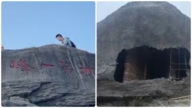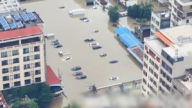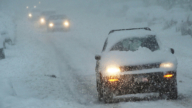【新唐人2013年03月15日訊】世界氣象組織專家經過多年觀測發現,被稱作「世界屋脊」的青藏高原地區,有85%至90%的冰川正在急劇融化,嚴重威脅未來數十億人的生活與生產。下面請一起來了解這個現象。
3月13號,世界氣象組織主辦的「極地觀測、研究與服務」會議,在中國大陸的甘肅省省會蘭州召開。專家組成員、中國科學院「寒區旱區環境與工程研究所」研究員效存德在會上說,中國從80年代加入所謂「極區」觀測和研究的行列,經過多年的觀測顯示,地球的「第三極」——青藏高原地區,85%至90%的冰川在退縮。
與會者之一——中國大陸的氣象局副局長徐小峰說,「第三極」正在顯著變暖,加劇冰雪融化,嚴重威脅未來數十億人的生活。
「第三極」是以青藏高原為中心,西起帕米爾高原和興都庫甚山脈,東到橫斷山脈,北起昆崙山和祁連山,南到喜瑪拉雅山脈。共有10萬平方公里的冰川,是長江、黃河、恆河等10多條亞洲大江大河的源區。
早在2005年,「青藏高原生態地質環境遙感調查與監測」項目,專家組的調查結果已顯示,青藏高原生態環境在30年間,出現了明顯惡化的趨勢:大面積冰川消退,平均每年減少147.36平方公里。鑑於青藏高原多個冰川雪線不斷上移,預料2090年冰川總面積將只剩50%。
關注環境保護的北京維權人士胡佳表示,2005年他去青藏高原的時候,發現那邊冰川確實在大面積退縮。
北京維權人士胡佳:「我們在西藏高原可可西里那邊,開車行進的時候,我們居然行進在大片的湖底,就原來是一片湖,昆明山那邊的王母瑤池,我們當時就在它那邊大片的湖,乾涸了,在那個湖底下,這個退化在過去的十年來講是相當明顯的。」
北京環保自願者張俊峰指出,近100年以來,全球氣候溫度整體上升。
北京環保自願者張俊峰:「上升的結果,就使得雪線從原來的2000米左右,一直上升到現在的距離(水平面)3000米。就使得大量的低於3000米以下的積雪和冰川發生融化,這種融化的結果還有一個潛在的現象是,使得地球大氣裏面的水汽結露點的海拔高度也跟著上升了,那麼就使得很多地區原來的泉水消失了,這也是造成了現在的水資源缺乏的這麼一個根源。」
張俊峰還表示,人類的農業系統依靠穩定的氣候系統支撐,氣候系統一旦發生極端變化,將會造成農業發生大面積的減產。張俊峰預測,未來非常可能出現這個狀況。
張俊峰:「另外的方面就是植被,生態系統受很大影響,會使得整個地球生態系統原來儲存能量、轉換能量的功能減弱,會使得地球全球變化的狀態變得越來越惡化,也就進入到一種惡性循環裏面去,也是把這個平衡點打破了,人類可能遭受自然災害的狀況會越來越頻繁。」
此外,氣候變暖還有一個最大的威脅,就是大面積冰川融化導致的海平面上升。據預測,如果平均氣溫上升1.5至4.5攝氏度,海平面將上升25至100厘米。海平面上升後,除了淹沒沿海低地外,海底地震和海洋風暴也會隨之增加,海洋潮汐也將發生變化。這些變化,將直接影響到沿海60千米範圍內,數十億人的社會經濟活動,世界上30%的大城市,將受到海潮的威脅,許多島嶼將從地圖上消失。
去年11月中旬,世界銀行發佈一份科研報告說,如果國際社會不採取措施抑制氣候變化,到本世紀末,全球氣溫將會升高4度,引發一連串的災難性,包括極端熱浪、全球糧食庫存下降、海平面上升、珊瑚礁死亡等,全世界各個地區將無一倖免。
採訪編輯/李韻 後製/郭敬
Qinghai-Tibet Glaciers Quick Melting Threatens Billions of Chinese
Experts of the World Meteorological Organization found
that after years of observation, 85-90% of the glaciers
are rapidly melting in the Qinghai-Tibet Plateau region,
which is known as “the roof of the world.”
This will become a serious threat to billions of people’s lives.
Let’s understand this phenomenon together.
On March 13th, a meeting regarding “Polar Observations,
Research and Services” organized by the
World Meteorological Organization was held in Lanzhou,
capital of Gansu Province.
Xiao Chengde, researcher at the Chinese Academy
of Sciences, said at the meeting that
China has joined the observation and study of the
so-called polar regions since 1980.
After years of observation, it shows that 85-90% of
glaciers in the Earth’s “Third Pole", Qinghai-Tibet Plateau region, is rapidly melting.
Xu Xiaofeng, Deputy Secretary of China Meteorological
Bureau, said the third pole is warming noticeably, which
exacerbates snow melting and threaten the lives of
billions of people in the future.
The third pole is based at the Qinghai-Tibet Plateau,
the west Pamir and Hindu Kush mountain range,
east of the Hengduan Mountains, north of the Kunlun
Mountains and Qilian Mountains, and south of the Himalayas.
A total of 100,000 square kilometers of glaciers is the source
of more than 10 major rivers in Asia, including the Yangtze River, the Yellow River, and the Ganges.
As early as in 2005, the ecological geological survey showed
that a marked deterioration occurred in the last 30 years in the Qinghai-Tibet Plateau’s ecological environment.
A large area of the glaciers receded, at the average reduction
of 147.36 square kilometers per year.
In view of the Qinghai-Tibet Plateau glacier snow line,
only 50% of the total glacial area will be left by 2090.
Hu Jia, environmental protection activist in Beijing, said,
when he went to the Tibetan Plateau in 2005, that he saw glaciers in a large area having retreated.
Hu Jia: “When traveling by car in Hoh Xil
of the Tibetan plateau, we actually drove in a large area—
the bottom of the Queen-Mother-Jade-Pound.
We were at a huge lake area, which had totally dried up.
The environmental degradation in the past decade
was quite obvious."
Zhang Junfeng, Beijing environmental protection volunteer,
pointed out that in the last 100 years, the overall global climate has increased.
Zhang Junfeng: “The global warming caused the snow line
to move up, from the 2000 meter mark above sea level to 3,000 meters.
Thus, a large amount of glaciers below 3,000 meters
started to melt.
In addition, the glacier-melting results in the rising altitude
of water vapor inside the Earth’s atmosphere.
Thus, many springs have disappeared and caused
water shortage nowadays.”
Zhang Junfeng commented that human agricultural systems
depend on a stable climate.
Once the climate system shows an extreme change, a decrease
in agricultural productions over a large area can take place.
Zhang predicts this would likely happen in the future.
Zhang Junfeng: “The vegetation and ecosystem would
also be seriously affected.
It weakens the functions of the original energy storage
and energy conversion of the entire planet.
It will worsen the Earth’s global change condition and
turn into a vicious cycle.
Once this balance point is broken, human beings would
encounter more natural disasters.”
The biggest threat of climate warming is that a large area
of glaciers melts and causes a rising sea level.
It is predicted that, if the average temperature increases from
1.5 to 4.5 degrees Celsius, the sea level will rise 25-100cm.
A sea level rise not only floods coastal lowlands, but also
affects the undersea earthquake, ocean storms and ocean tides.
These changes will have a direct impact on cities within
60 kilometers of the coast and socio-economic activities of billions of people.
30% of the world’s major cities will be subject to the threat
of ocean tides, and many islands will disappear from the map.
In mid-November 2012, the World Bank released
a research report, saying
if the international community does not take steps
to curb climate change,
the global temperature will rise by four degrees by
the end of this century, triggering a series of catastrophes
including extreme heat waves, global food stocks decline,
rising sea levels, and dying coral reefs. The entire world will be affected.




























